Captain Herbert Haddock
- Belfast Dummy Fleet
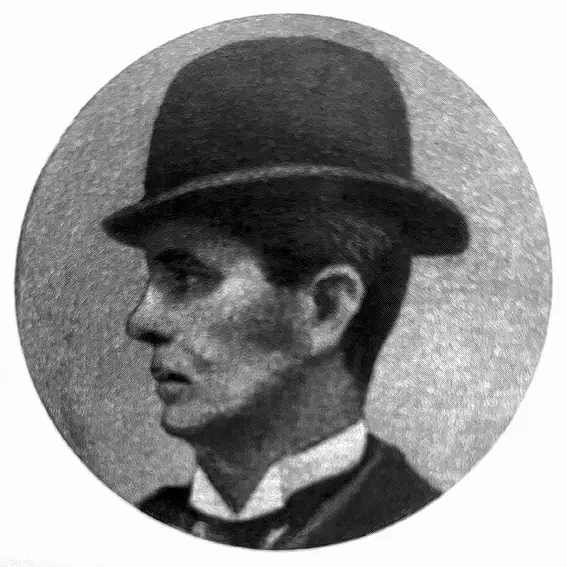
Captain Haddock pictured in the French newspaper of the First World War, Le Pays de France, 28 February 1918 ("Le Vrai Capitaine Haddock," Louis Francken)
After the HMS Audacious rescue, the Olympic was taken out of passenger service and laid up in November 1914. The Admiralty then placed Haddock in charge of a dummy fleet of merchant ships, stationed at Belfast. Construction of the dummy fleet was undertaken by Harland and Wolff, who at the time were finishing work on the third Olympic class ship: Britannic.
The appointment of Haddock was in the immediate aftermath of his efforts rescuing the Audacious - infact the concept was in place within a week according to a 1941 article:
The following day Admiralty orders were issued to several shipyards to create a squadron of dummy battleships. Captain Haddock hmself was chosen to command the new squadron whose personnel was to be drawn mainly from the Mercantile Marine.
There were however to be a commander and two lieutenants of the Royal Navy Reserve in each ship in charge of the confidential books and signals. Captain Haddock was given the rank of Commodore.
Within a week of the loss of Audacious ten merchant vessels had been acquired for conversation into battlehips, and 2,000 dockyard workers at Belfast and eslewhere were secretly engaged night and day on the task of fitting them out for their new role.
(Sunday Sun (Newcastle upon Tyne) 19 January 1941)
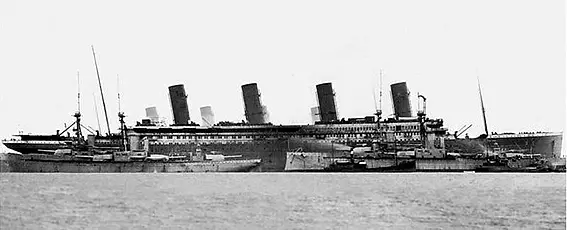
In front of the HMS Britannic, being fitted out, are the SS City of Oxford and SS Michigan disguised as HMS St. Vincent and HMS Collingwood.
(Click image to enlarge)
Stewardess Violet Jessop described Haddock in her memoirs as commanding "Q-boats" - but technically these were not the same. "Q-boats" are heavily armed merchant ships with concealed weaponry, designed to lure submarines into making surface attacks. However, Haddock was in charge of a "dummy fleet" of merchant ships, described as "imitation capital ships" fitted with dummy turrets, funnels and other superstructure made of wood:
"Masquerade Battle Fleet"
During World War I, the Royal Navy decided to convert a select number of merchant ships, particularly ocean liners, into imitation capital ships. Fourteen ships in total were selected for the task, each re-modelled individually with mock turrets, guns and other sham devices made of wood and canvas, and specially ballasted, to enable them to masquerade as the capital ships of the Grand Fleet. Just how successful these dummy battleships and battlecruisers were is not known. The objective behind the subterfuge was to confuse the enemy over fleet dispositions as well as to mislead them as to the actual total fleet strength. Only the Merion, disguised as the battlecruiser, HMS Tiger, was lost during the war, while in support of the Dardanelles Campaign, in the Aegean Sea by UB8 on 30 May 1915. Of the other thirteen, two were expended as blockships (such as the Oruba as HMS Orion) and the other eleven diverted to other duties by the beginning of 1916.
(Liners In Battledress by David Williams - Vanwell Publishing Ltd. c-1989/Cliff McMullen)
There were 14 "dummy" ships involved:
1. City of Oxford (Ellerman) as HMS St. Vincent
2. Michigan (Warren) as HMS Collingwood
3. Montezuma (Canadian Pacific) as HMS Iron Duke
4. Ruthenia (Canadian Pacific) as HMS King George V
5. Tyrolia (Canadian Pacific) as HMS Centurian
6. Oruba (Orient) as HMS Orion
7. Mount Royal (Canadian Pacific) as HMS Marlborough
8. Montcalm (Canadian Pacific) as HMS Audacious
9. Princess (ex- Kronprinzessin Cecilie) as HMS Ajax (Hamburg Amerika)
10. Perthshire (Federal SN) as HMS Vanguard
11. Cevic (White Star) as HMS Queen Mary
12. Manipur (Brocklebank) as HMS Indomitable
13. Patrician (Harrison) as HMS Invincible
14. Merion (American) as HMS Tiger
As seen above, one of these ships was the White Star Line's Cevic - Henry Wilde and David Blair had served aboard the Cevic previously. The White Star sold the Cevic to the Admiralty in October 1914 and in December, was converted to a dummy capital ship by Harland and Wolff at Belfast. Fitted with two extra dummy funnels and wooden turrets, she masqueraded as the battlecruiser HMS Queen Mary. Also in this list is the Montcalm of the Canadian Pacific line masquerading as HMS Audacious - the very ship from which Haddock had rescued crew and tried to save before it sank the year before.
By the end of 1914 five ships were completed and three months later another five - officially known as the "Special Service Squadron and the Tenth Battle Squadron." Most were first sent to Scapa Flow, and later Loch Ewe on the west coast of Scotland for practice manoeuvres "for their proosed operations on the high seas unde the direction of Captain Haddock, who was in the flagship Ajax - ironically enough originally a German ship."(Sunday Sun (Newcastle upon Tyne) 19 January 1941)
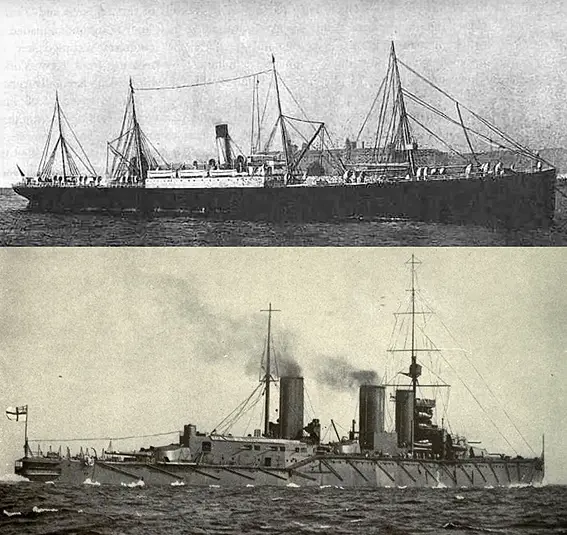
The Cevic before and after as a "dummy" ship. Bottom: Fitted with two extra dummy funnels and wooden turrets to masquerade as the battlecruiser HMS Queen Mary.
(Click image to enlarge)
Sir Winston Churchill was apparently behind the plan and wrote in October 1914:
It is necessary to construct without delay a dummy fleet. Ten merchant vessels...should be selected at once. They should be distributed among various private yards not specially burdened with warship building at the present time. They are then to be... mocked up to represent fast battleships of the First and Second Battle Squadrons. The actual size need not correspond exactly, as it is notoriously difficult to judge the size of vessels at sea, and frequently even destroyers are mistaken for cruisers.
We are bearing in mind particularly aerial and periscope observation where deception is much more easy... Very little metal would be required, and practically the whole work should be executed in wood or canvas."
He explains, "Even when the enemy knows that we have such a fleet its presence will tend to mystify and confuse his plans, and baffle and distract the enterprise of his submarines. He will always be in doubt as to which is the real and which is the dummy fleet." (eaglespeak.us)
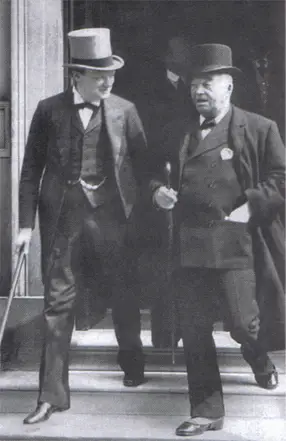
Lord Fisher and Winston Churchill, First Lord
of the Admiralty, in 1913. The "Dummy Fleet"
was apparently Churchill's idea and Fisher
described Haddock as "a Nelson of the
Merchant Service". (Photograph: wikipedia)
Haddock's appointment came from John Fisher (1st Baron Fisher), who, although retired from the Admiralty became First Sea Lord again in November 1914. In his memoirs, published in 1919 ("Memories" by Lord Fisher), he mentions that upon becoming First Sea Lord, he "at once" contacts Herbert Haddock and makes him a Commodore and appoints him to command "the finest fleet of dummy wooden 'Dreadnoughts' and Battle Cruisers the world had ever looked on... if ever there was a Nelson of the Merchant Service he was," and that if Fisher had remained First Sea Lord "he would have been Sir Herbert Haddock, K.C.B., or I'd have died in the attempt." ("Memories" by Lord Fisher, 1919)
Although it was likely supposed to be kept secret, The New York Times published an early rumour about the dummy fleet in December 1914, including that it would be overseen by Haddock:
HEARS BRITISH PLAN A DUMMY FLEET;
Baltic Passenger Thinks Liners Are Being Filled with Cement to Block Kiel Canal.
TO CARRY WOODEN GUNS Turrets, Also of Wood, Are Put on the Decks to Make Ships Resemble Men-o'-War.
Dec. 20, 1914
A tale of a British naval trick in process of preparation, the purpose of which was not quite clear, was brought to New York yesterday by a passenger on the White Star liner Baltic from Liverpool.
The passenger told of the fitting out of fifty dummy warships...These vessels are old steamships of various tonnage and speed...
The purpose for which they are intended is being kept secret...
In an interview with a Times reporter at his hotel, the passenger... said that the work was being carried on day and night...
"After the interior fittings of the ships have been ripped out," the passenger said, "the hulls are strengthened with extra steel beams and the holds filled with cement or some product of similar nature to sink them level with the water. Then the upper works are painted a naval gray and wooden turrets and wooden guns are mounted on their decks. Through a friend in the shipyard I looked over one old passenger liner that was being fitted with nine-inch guns and looked quite formidable. While I was there a painter who was working on a dummy funnel fell out of the bo'suns chair he was sitting in, went through the turret and smashed the gun inside.
"Of course, all these things are very lightly constructed and have to be handled carefully. An able seaman, who was carrying a 'ten-ton' anchor on his shoulder along the deck was admonished by the bo'sun to go easy or he would break the mudhook in two amidships..."
Even later newspapers continued to report about the dummy fleet, such as The New York Times, 21 March 1915 which mentioned that a fleet of dummy warships built under the supervision of White Star Capt. Herbert J. Haddock sailed from Belfast on a secret mission. The report states that it is unknown whether Haddock sailed with the fleet and, except that he is not in Liverpool, "nothing is known in shipping circles there about his movements."
Additionally, a 3rd of October 1915 edition of The New York Times reported on White Star Capt. Herbert Haddock's service as commander of a "dummy fleet" of merchant ships (Cevic among them) masquerading as warships. The ships are made to resemble battleships and cruisers "by means of wood, paint and putty," the Times reports, and are then dispatched to decoy German warships and deter U-boat activity. British Admiral John Jellicoe is said not to have recognized the fleet as "dummies" when he encountered it last November and the sinking of the German cruiser Blücher in January is attributed to the activity of Haddock's command. (The New York Times, 3 October 1915.)
A Success?
According to the book "Castles of Steel: Britain, Germany, and the Winning of the Great War at Sea" by Pulitzer Prize-winner Robert K. Massie, the dummy fleet was ineffective as it was too slow and the ships were all different sizes and so would fool no-one and the Germans were aware of the ruse early on. However an article in The Times of 1918 proposed otherwise:
"WAR'S BIGGEST TRICK: "THE SUICIDE FLEET"; British Squadron of Fourteen Wooden Ships; with Wooden Guns, Deceived Germans for Months...."
The wooden ships without a single real weapon aboard - British Navy men called them "mock turtles" - helped Britannia rule the waves during the first year of the war, and the Germans never once suspected that they were aught but what they seemed. The foe did not catch on to the joke even when one of their submarines sank a dummy at the Dardanelles where it was serving as a mail ship for the allied fleets. They announced and rejoiced that "a British battleship... was sunk by one of our submarines," although the huge guns and turrets of the dreadnought floated for days about the entrance to Stamboul!
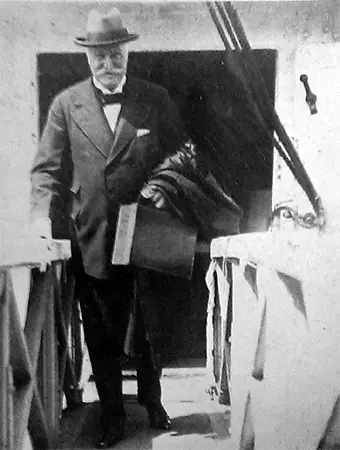
Harold Sanderson photographed aboard the Olympic
in 1925. Sanderson wanted Haddock to take command
of the Britannic. (White Star Magazine/Paul Lee)
September 1915: Britannic?
According to Simon Mills' book "HMHS Britannic: The Last Titan," Harold Sanderson tried to have Haddock re-assigned in 1915, to command Britannic when she entered service as a hospital ship, but could not succeed in convincing the Admiralty to release Haddock from his Belfast duties. Mark Chirnside's book "RMS Olympic: Titanic's Sister" also mentions the Olympic being requisitioned for use as a troopship in September 1915. Because the Admiralty would not release Herbert Haddock, Olympic's peace-time captain and White Star's first choice for command, from his duties at Belfast as head of a fleet of dummy war ships, Bertram F. Hayes was appointed as Olympic's commander.
December 1915: Disbanded
On the 18th of December 1915, information reached New York "from reliable sources in London" that the fleet of dummy warships created by Harland and Wolff and commanded by White Star's Captain Herbert Haddock had been disbanded. The thirteen surviving ships of that fleet had their fake guns, turrets and funnels removed at Glasgow or Belfast and been reassigned to other duties. (The New York Times, 19 December 1915)
See also...
Next... Retirement & Death